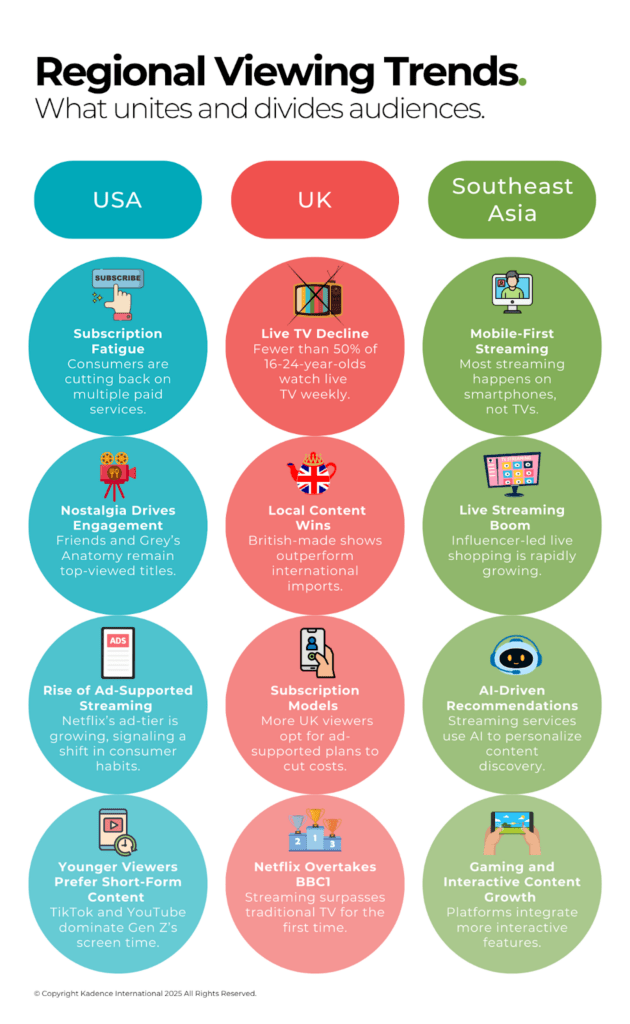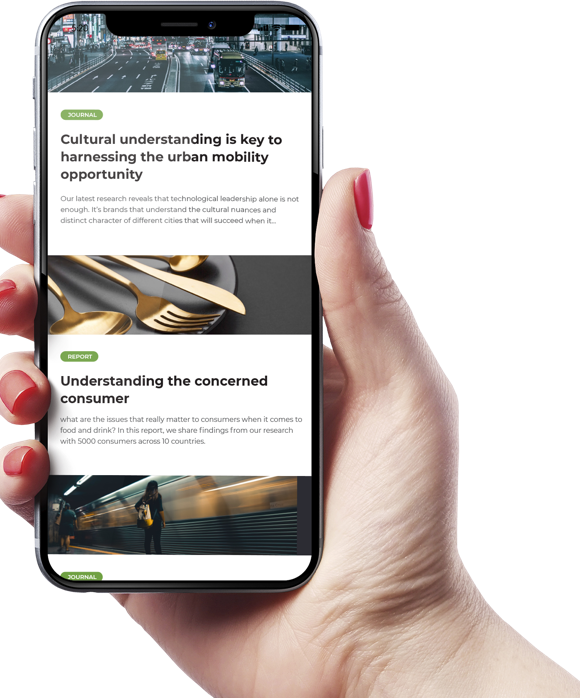Streaming is no longer an emerging trend – it has firmly established itself as the dominant mode of entertainment. Yet, how people stream content varies significantly by region and generation. While the US, UK, and Southeast Asia all favour on-demand viewing, regional and demographic nuances are shaping the next phase of the industry.
In the US, streaming now accounts for 43% of total TV consumption – more than double its share from a few years ago. However, subscription fatigue is rising, with nearly one-third of consumers cancelling at least one service in the past year. As a result, ad-supported models are gaining ground, providing brands with new ways to reach audiences moving away from traditional paid subscriptions.
In the UK, live TV’s decline is accelerating, particularly among younger viewers. In 2023, fewer than half of 16-24-year-olds watched live television weekly. As streaming overtakes traditional viewing, Netflix has pulled ahead of BBC1 in total audience reach. The demand for locally produced content remains strong, prompting global platforms to increase investment in British programming to retain subscribers.
In Southeast Asia, a mobile-first approach defines the streaming landscape, with over 90% of users accessing content via smartphones. This preference fuels a strong demand for locally produced content, often surpassing global franchises in popularity. Live streaming, frequently combined with e-commerce, has emerged as a significant engagement tool, allowing consumers to interact with sellers in real-time. Additionally, the region is at the forefront of AI-driven content recommendations, as platforms utilise advanced algorithms to enhance user experiences.
Streaming preferences vary significantly across generations. Gen Z and Millennials gravitate towards short-form, socially-driven content, with platforms like TikTok and YouTube being particularly popular. In contrast, Gen X and Baby Boomers lean towards longer, ad-free viewing experiences, often favouring traditional television and subscription-based streaming services. Despite these differences, binge-watching is a common behaviour across all age groups. Notably, younger viewers are increasingly engaging with interactive content, reflecting their desire for more immersive experiences.
The Rise of Streaming and the Decline of Traditional TV
The shift from traditional television to streaming is now undeniable, reshaping how audiences consume content across global markets. While linear TV still holds relevance in certain demographics, the numbers tell a different story:
- In the US, streaming accounts for 41.6% of total TV consumption, with cable and broadcast TV dropping below 50% for the first time.
- In the UK, Netflix has surpassed BBC1 in total viewership, a milestone that signals a permanent shift toward on-demand content.
- In Southeast Asia, 71% of TV viewers now consume ad-supported streaming, putting digital platforms on par with traditional television in the region.
This shift isn’t just about technology – it’s about consumer behaviour. Audiences today demand flexibility, personalisation, and content tailored to their interests, leaving behind the rigid schedules of linear programming. Younger viewers, in particular, are turning away from appointment-based TV, opting instead for platforms that provide immediate, algorithm-driven recommendations.

Regional Viewing Trends: What Unites and Divides Audiences?
Streaming trends vary widely across regions, influenced by cultural preferences, technological access, and economic factors. While some viewing habits are universal, key differences reinforce the need for region-specific content and marketing strategies.
United States
In the US, subscription fatigue is reshaping streaming habits. While platforms dominate TV consumption, 42% of users feel overwhelmed by too many choices, and nearly half plan to cancel at least one service. This has accelerated the shift to ad-supported tiers, with 39% of Netflix’s new subscribers opting for its lower-cost, ad-backed plan.
To counteract subscription fatigue and attract cost-conscious viewers, streaming platforms are increasingly embracing ad-supported models. The success of these tiers signals a growing consumer preference for lower-cost options over premium, ad-free experiences.
Image: Grey’s Anatomy
Despite the surge in new content, licensed shows continue to dominate streaming viewership. In 2024, Grey’s Anatomy ranked as the second most-watched streaming program, amassing 47.85 billion minutes viewed across Hulu and Netflix. Friends remains a staple on streaming platforms, while classic titles like The Big Bang Theory and Little House on the Prairie also saw significant engagement. The sustained popularity of older programs highlights the enduring appeal of nostalgia-driven content and the power of deep, long-running libraries.
United Kingdom
The UK’s youngest viewers are turning away from live TV, with less than half of 16-24-year-olds watching it weekly. Streaming platforms have stepped in to capture this audience, and Netflix now commands a larger share of viewership than BBC1. Meanwhile, investment in British-made productions is driving subscriptions, reinforcing the appeal of localised content.
A strong preference for locally produced content continues to shape the UK streaming market. Platforms are responding with increased investment in British programming, recognising its role in retaining subscribers and differentiating services in a competitive landscape.
Ad-supported streaming is also gaining momentum, offering cost-conscious viewers an alternative to rising subscription fees. For advertisers, this shift creates new opportunities to engage audiences within premium, on-demand environments.
Image: Mr Bates vs The Post Office
In 2024, several television programs captured the attention of UK audiences, reflecting diverse viewing preferences. Mr Bates vs The Post Office became the most-watched program of the year, drawing nearly 14 million viewers on ITV. Meanwhile, American sitcoms continue to dominate streaming, with The Big Bang Theory topping charts at 63.1 million views, followed by Friends with 55.8 million views. Netflix’s Black Doves, a recent release, amassed 57.7 million views, demonstrating the platform’s ability to drive audience engagement. These trends highlight the UK’s dual appetite for homegrown dramas and globally recognised franchises, reinforcing the importance of a diverse content library for streaming platforms.
Southeast Asia
Mobile streaming dominates Southeast Asia, where most viewers watch content on smartphones rather than TVs. Unlike Western markets, where streaming services compete for subscription revenue, free-to-watch and ad-supported content drive engagement, with AI-powered recommendations shaping viewing habits.
Local and regional content dominates viewer preferences, with audiences favouring stories and characters that resonate with their own experiences. This demand has spurred a surge in locally produced content, catering to the diverse linguistic and cultural landscape of the region.
Live streaming and social commerce are reshaping the entertainment paradigm. Platforms are increasingly integrating shopping features into live broadcasts, creating interactive experiences that blend entertainment with e-commerce.
Artificial intelligence is playing an influential role in content recommendations, enhancing user engagement by tailoring suggestions to individual viewing habits. This personalisation fosters deeper connections between viewers and platforms, driving sustained engagement.
Collectively, these regional trends highlight the multifaceted nature of the global streaming ecosystem. While certain viewing habits transcend borders, nuanced differences underscore the necessity for brands and content creators to adopt region-specific strategies to effectively engage diverse audiences.
Image: Vikram Vedha
Southeast Asia’s top content reflects the region’s diverse tastes and growing demand for localised programming. In 2024, the highest-grossing show on Netflix was Vikram Vedha (a hit in Indonesia and Thailand), racking up 45 million views in just one month. Korean dramas are also a key driver, with Crash Landing on You earning 58 million views across Southeast Asia, highlighting the region’s preference for international content that still feels locally relatable. Meanwhile, Indonesian dramas like Tiga Dara saw a surge, with 20 million views on local streaming platforms like GoPlay. This shows the growing need for platforms to balance global hits with region-specific content.
The Generational Divide in Streaming Habits Gen Z and Millennials
Streaming habits are deeply shaped by generational preferences, with younger audiences favoring social-driven, short-form content, while older viewers remain loyal to traditional long-form programming.
Gen Z and Millennials
Gen Z and Millennials consider streaming an extension of their digital ecosystem, where content is discovered through social media platforms like TikTok and YouTube, not traditional TV guides. Their preferences lean toward short-form, algorithm-driven entertainment, emphasising speed, interactivity, and shareability. The rise of gaming-integrated streaming further caters to their desire for immersive, participatory experiences.
Gen X and Baby Boomers
Gen X and Baby Boomers gravitate toward long-form content, including feature films and multi-season TV series. They prioritise ad-free experiences, choosing premium streaming options over ad-supported models. Nostalgia drives their content choices, as they revisit classic shows and familiar genres instead of new releases. Unlike younger audiences, they prefer a slower pace, showing more loyalty to scheduled programming and series they can follow over time.
The Universality of Binge-Watching
Binge-watching transcends generational divides, becoming a common behaviour across all age groups. 72% of TV viewers report watching at least three episodes in one sitting, showing that while content preferences may differ, the desire for extended viewing sessions is universal.
The Future of Streaming: What the Numbers Predict
The future of streaming is being shaped by three key trends: AI-driven content discovery, the rise of ad-supported tiers, and a growing focus on live content. As audiences increasingly demand personalisation, affordability, and real-time engagement, platforms that fail to keep pace risk losing relevance.
The Growing Role of AI in Shaping Recommendations
Artificial intelligence is playing an increasingly vital role in streaming platforms, driving personalised content recommendations. Netflix, for instance, attributes 80% of viewer activity to its AI-driven recommendations, a strategy that is estimated to save the company $1 billion annually in customer retention.
Amazon Prime Video is also exploring AI through its “AI Topics”, which curates content categories based on individual interests, offering a more tailored and intuitive content discovery experience.
The Rise of Hybrid Models
In response to diverse consumer preferences, many streaming services are adopting hybrid monetisation models that blend subscriptions with ads. Disney+, Netflix, and Amazon Prime have launched ad-supported tiers, providing more affordable options for viewers while expanding revenue streams.
This approach seeks to balance user experience with profitability, accommodating both ad-tolerant and ad-averse audiences.
Increased Investment in Regional Content
Streaming giants are investing heavily in regional content to better engage local audiences and strengthen their subscriber base. By producing and promoting local programming, platforms can build deeper connections with viewers, enhancing loyalty. This approach not only broadens their subscriber base but also enriches the global content library with diverse cultural narratives.
Streaming’s Push into Live Sports and Event-Based Content
Streaming services are increasingly venturing into live sports and event-based programming, capitalising on the enduring appeal of real-time content. Netflix, for example, is exploring opportunities in live sports and video games, aiming to diversify its offerings and attract a wider audience.
This shift signals a move toward more immediate and dynamic content, challenging traditional broadcast models.
Impact of Hollywood’s Production Slowdown
Hollywood’s production slowdown is beginning to affect streaming platforms, leaving fewer new titles for viewers accustomed to a steady flow of fresh content. As a result, platforms must turn to diversified content strategies, such as investments in international productions and alternative programming, to keep subscribers engaged during periods of limited new releases.
What This Means for Brands and Marketers
For brands, streaming’s evolution presents both challenges and opportunities. Success hinges on market research, allowing companies to tailor content and advertising to shifting viewer behaviours.
The Importance of Streaming Data for Audience Segmentation
Streaming platforms generate vast amounts of data, offering insights into viewer behaviours, preferences, and engagement patterns. By analyzing this data, brands can segment audiences more precisely, tailoring content and advertisements to specific demographics and viewing habits. This targeted approach enhances marketing efficiency by directing efforts toward the most receptive audience segments.
Adapting Media Strategies to Shifting Viewing Habits
As consumer viewing habits evolve, brands must adjust their media strategies accordingly. The decline of traditional television and the rise of on-demand streaming necessitate a reevaluation of advertising channels. Investing in streaming platforms, particularly those offering ad-supported models, allows brands to reach audiences where they are increasingly spending their time. Additionally, understanding peak viewing times and content preferences can inform the timing and placement of advertisements, maximising impact.
Crafting Platform-Specific Content
Different streaming platforms cater to varied audience preferences and content formats. For instance, TikTok thrives on short-form, viral content, while platforms like Netflix and YouTube accommodate longer-form videos. Brands should develop platform-specific content strategies, ensuring that the style, length, and messaging align with the expectations of each platform’s user base. This approach not only enhances engagement but also demonstrates an understanding of the platform’s culture and audience.
Leveraging Influencers to Drive Engagement
Influencers play a pivotal role in shaping viewer perceptions and driving engagement on streaming platforms. Collaborating with influencers who resonate with target audiences can amplify brand messages and foster trust. These partnerships can take various forms, including sponsored content, product placements, or co-created material. Given influencers’ ability to authentically connect with their followers, such collaborations often result in higher engagement rates compared to traditional advertising methods.
Exploring Opportunities in Interactive Content and Partnerships
Interactive content, such as polls, quizzes, and live Q&A sessions, encourages active audience participation, leading to deeper engagement. Brands can integrate interactive elements into their streaming content to create immersive experiences that captivate viewers. Additionally, forming partnerships with content creators or streaming platforms can provide access to new audiences and innovative content formats. For example, collaborating on exclusive content or sponsoring popular series can enhance brand visibility and association with high-quality programming.
Adapting to Changing Audience Behaviors
As streaming platforms reshape how audiences consume media, brands are under pressure to respond to rapidly changing viewer behaviours. The era of broad, generalised marketing strategies is fading. Success now depends on brands’ ability to customise content and marketing to fit specific regional trends and audience demands. Those that effectively leverage data-driven insights and align their messaging with platform-specific cultures will be better positioned to build stronger relationships with consumers and stay ahead in a crowded and competitive market.
A New Era of Streaming Requires a New Playbook
The one-size-fits-all content strategy is dead. Brands that fail to localise, personalise, and diversify their streaming approach will be left behind. The future belongs to those who stop chasing trends—and start using market intelligence to shape them. Today, audience behaviour is shaped by regional preferences, generational divides, and technological disruption – forces that demand a more sophisticated, localised, and data-driven approach from brands and content creators.
For years, global entertainment operated on the assumption that content produced for one audience could seamlessly translate to another. That model no longer holds. The numbers tell the story – while US viewers remain captivated by nostalgia-driven programming, younger audiences in the UK are abandoning linear TV entirely, and Southeast Asia’s mobile-first users are redefining engagement through live streaming and AI-driven recommendations. If streaming platforms and brands fail to recognise these shifts, they risk becoming irrelevant in key markets.
Localisation Is No Longer Optional
Local content is no longer a niche offering – it is a competitive necessity. Global streaming giants are pouring billions into regional productions because they have seen the data: subscribers are more loyal to platforms that cater to their cultural and linguistic preferences. In Southeast Asia, hyper-local content consistently outperforms Western programming. In the UK, British-made series draw more sustained engagement than many high-budget imports. A global strategy must start with a deep understanding of audience preferences at the local level – a reality that only market research can fully capture.
Agility Is the Only Way Forward
Streaming is not just replacing television; it is fragmenting it beyond recognition. The rise of ad-supported tiers, the growing dominance of TikTok-style short-form content, and the push toward interactive programming all signal that consumer habits will continue to evolve at breakneck speed. The platforms and brands that succeed will not be those clinging to legacy strategies, but those that move fast, test often, and adapt constantly.
In this new era of streaming, the winners will not be those with the biggest budgets but those with the best insights. The days of assuming global audiences behave the same way are over. For brands and marketers, the only way forward is a strategy that is localised, data-backed, and built for change.
Get regular insights
Keep up to date with the latest insights from our research as well as all our company news in our free monthly newsletter.





 Senior Marketing Executive
Senior Marketing Executive Sales & Marketing
Sales & Marketing General Manager PR -Internal Communications & Government Affairs
General Manager PR -Internal Communications & Government Affairs Vital Strategies
Vital Strategies
 Customer Intelligence Director
Customer Intelligence Director